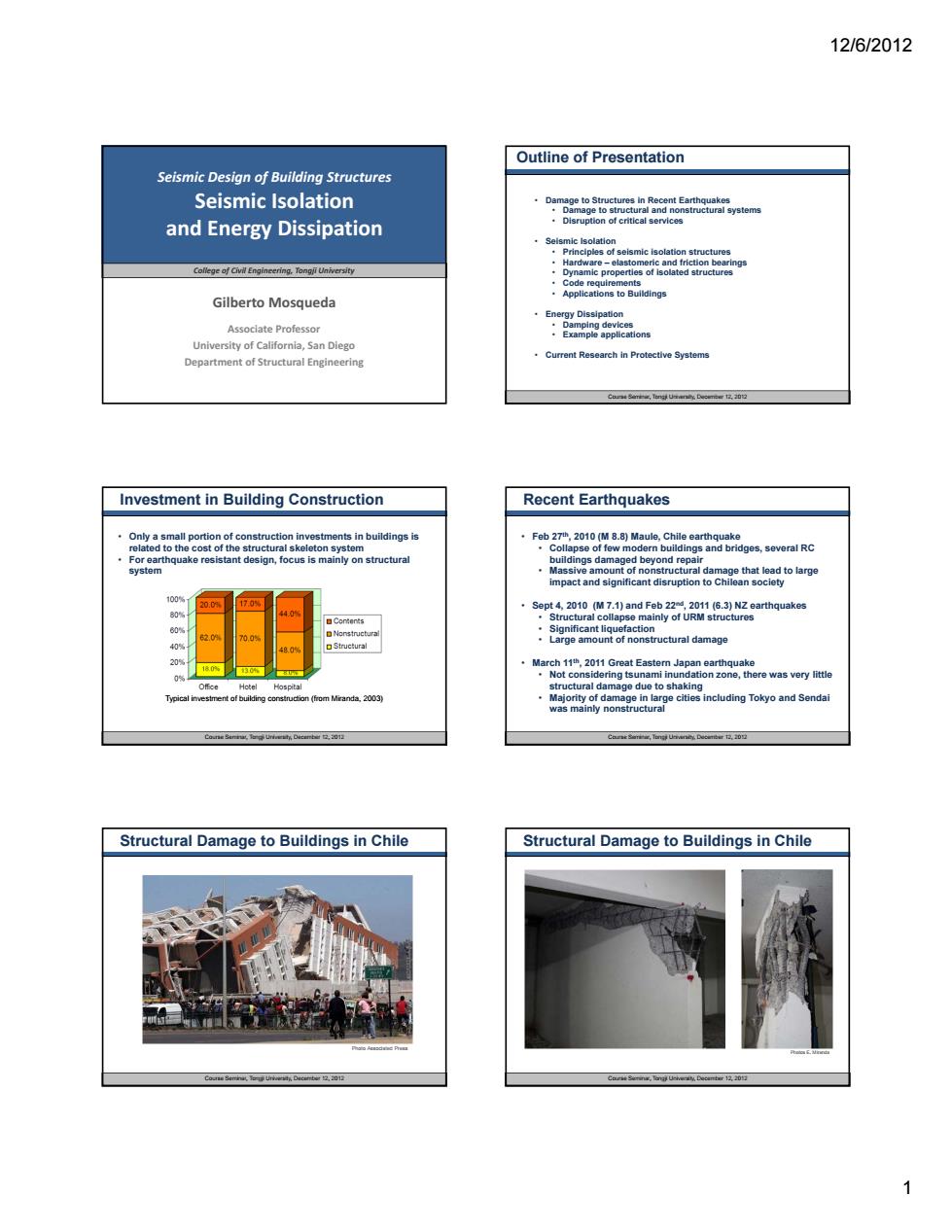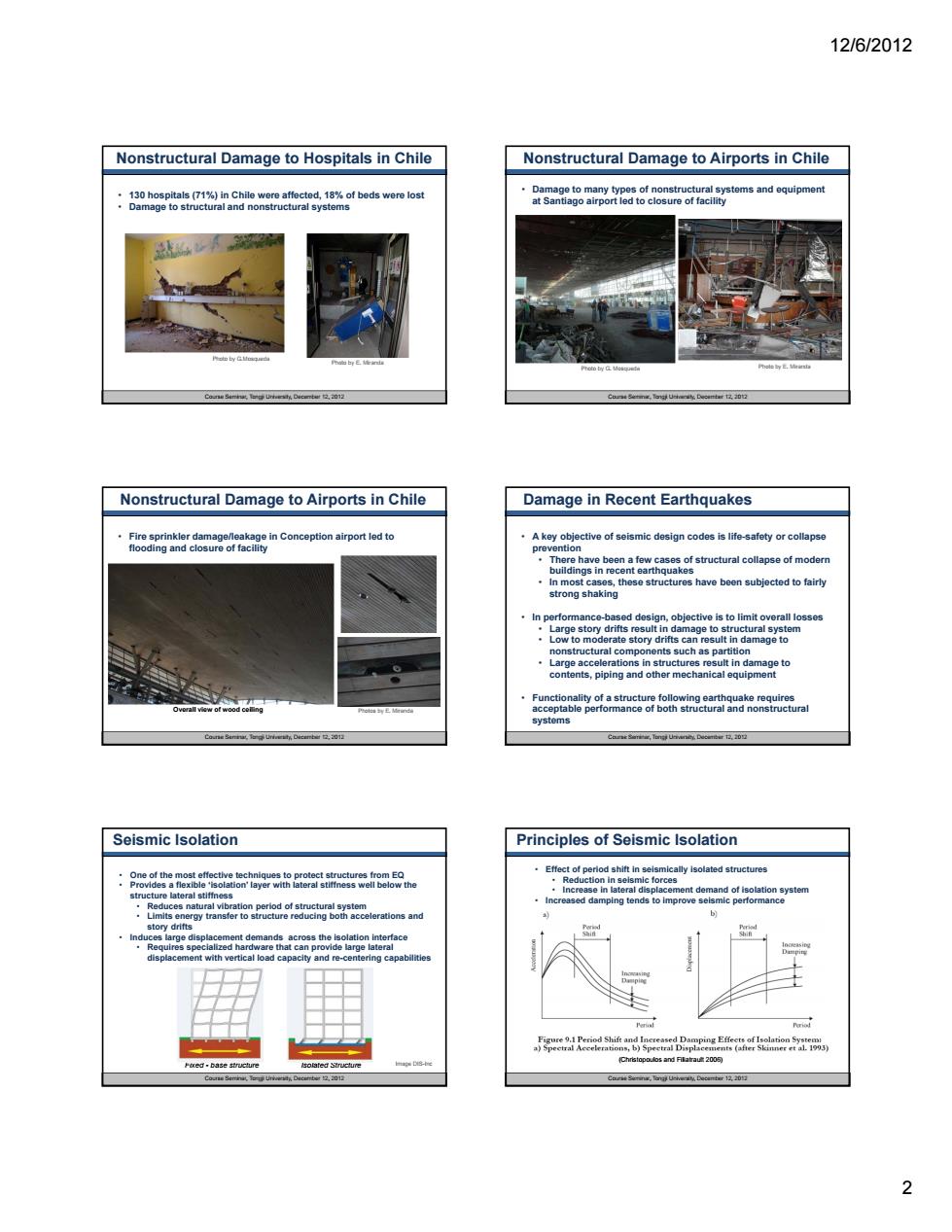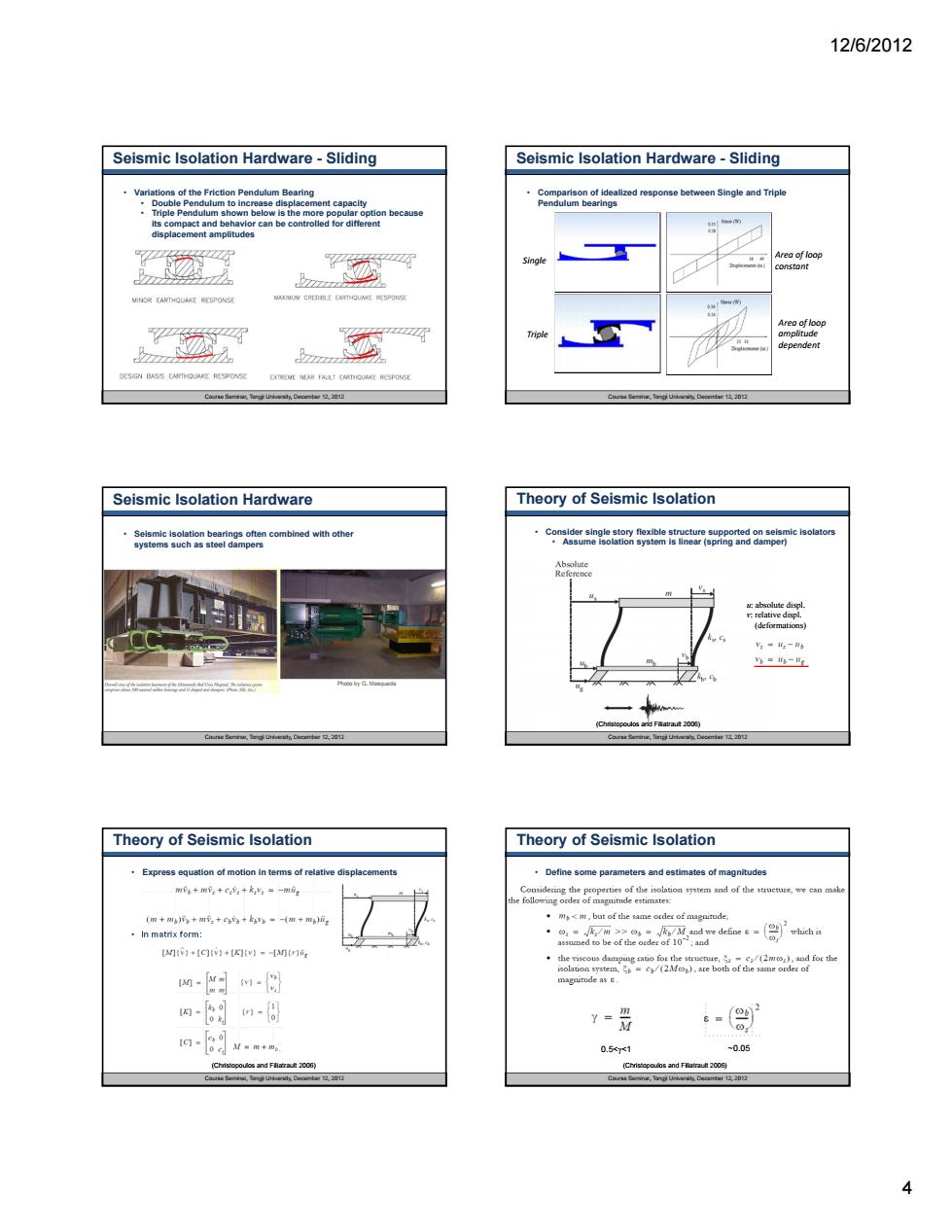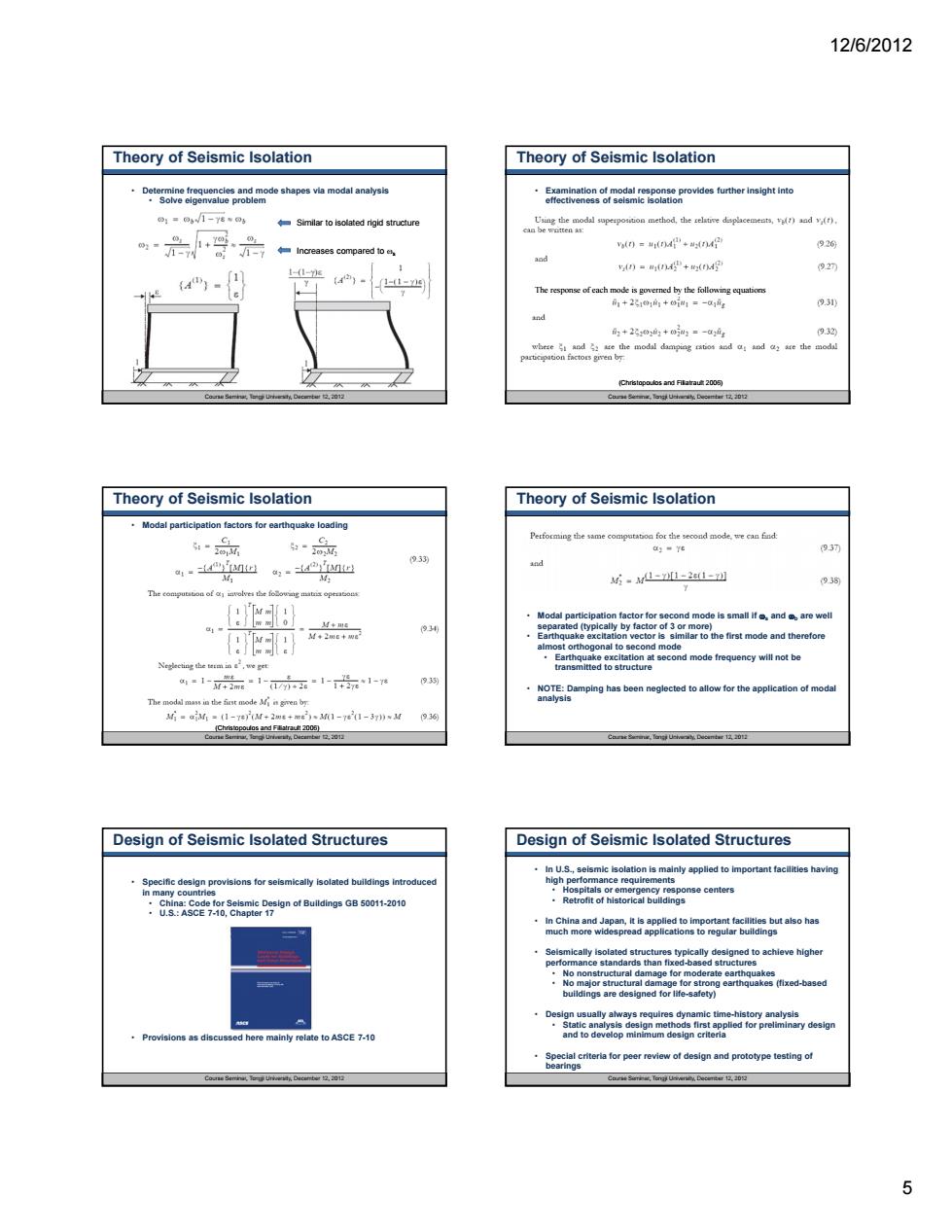
12/6/2012 Outline of Presentation Seismic Design of Building Structures Seismic Isolation and Energy Dissipation Gilberto Mosqueda Associate Professor of Structural Engineering Investment in Building Construction Recent Earthquakes p()and Feb (NZ arthquake uctural damage r3garmgn2a。wasvey Structural Damage to Buildings in chile Structural Damage to Buildings in Chile 1
12/6/2012 1 College of Civil Engineering, Tongji University Seismic Design of Building Structures Seismic Isolation and Energy Dissipation Gilberto Mosqueda Associate Professor University of California, San Diego Department of Structural Engineering Course Seminar, Tongji University, December 12, 2012 Outline of Presentation • Damage to Structures in Recent Earthquakes • Damage to structural and nonstructural systems • Disruption of critical services • Seismic Isolation • Principles of seismic isolation structures • Hardware – elastomeric and friction bearings • Dynamic properties of isolated structures • Code requirements • Applications to Buildings • Energy Dissipation • Damping devices • Example applications • Current Research in Protective Systems Course Seminar, Tongji University, December 12, 2012 Investment in Building Construction • Only a small portion of construction investments in buildings is related to the cost of the structural skeleton system • For earthquake resistant design, focus is mainly on structural system Typical investment of building construction (from Miranda, 2003) Course Seminar, Tongji University, December 12, 2012 Recent Earthquakes • Feb 27th, 2010 (M 8.8) Maule, Chile earthquake • Collapse of few modern buildings and bridges, several RC buildings damaged beyond repair • Massive amount of nonstructural damage that lead to large impact and significant disruption to Chilean society • Sept 4, 2010 (M 7.1) and Feb 22nd, 2011 (6.3) NZ earthquakes • Structural collapse mainly of URM structures • Significant liquefaction • Large amount of nonstructural damage • March 11th, 2011 Great Eastern Japan earthquake • Not considering tsunami inundation zone, there was very little structural damage due to shaking • Majority of damage in large cities including Tokyo and Sendai was mainly nonstructural Course Seminar, Tongji University, December 12, 2012 Photo Associated Press Structural Damage to Buildings in Chile Course Seminar, Tongji University, December 12, 2012 Photos E. Miranda Structural Damage to Buildings in Chile

12/6/2012 Nonstructural Damage to Hospitals in Chile Nonstructural Damage to Airports in Chile Nonstructural Damage to Airports in Chile Damage in Recent Earthquakes desian codes is life-safety or c been subjected to fai Seismic Isolation Principles of Seismic Isolation 代运1 2
12/6/2012 2 Course Seminar, Tongji University, December 12, 2012 Photo by E. Miranda Ceiling-sprinkler head dynamic interaction Nonstructural Damage to Hospitals in Chile • 130 hospitals (71%) in Chile were affected, 18% of beds were lost • Damage to structural and nonstructural systems Photo by G.Mosqueda Course Seminar, Tongji University, December 12, 2012 Closeup view of some sprinkler heads sheared off Photo by E. Miranda Ceiling-sprinkler head dynamic interaction Nonstructural Damage to Airports in Chile • Damage to many types of nonstructural systems and equipment at Santiago airport led to closure of facility Photo by G. Mosqueda Course Seminar, Tongji University, December 12, 2012 Overall view of wood ceiling Photos by E. Miranda Ceiling-sprinkler head dynamic interaction Nonstructural Damage to Airports in Chile • Fire sprinkler damage/leakage in Conception airport led to flooding and closure of facility Course Seminar, Tongji University, December 12, 2012 Damage in Recent Earthquakes • A key objective of seismic design codes is life-safety or collapse prevention • There have been a few cases of structural collapse of modern buildings in recent earthquakes • In most cases, these structures have been subjected to fairly strong shaking • In performance-based design, objective is to limit overall losses • Large story drifts result in damage to structural system • Low to moderate story drifts can result in damage to nonstructural components such as partition • Large accelerations in structures result in damage to contents, piping and other mechanical equipment • Functionality of a structure following earthquake requires acceptable performance of both structural and nonstructural systems Course Seminar, Tongji University, December 12, 2012 Seismic Isolation • One of the most effective techniques to protect structures from EQ • Provides a flexible ‘isolation’ layer with lateral stiffness well below the structure lateral stiffness • Reduces natural vibration period of structural system • Limits energy transfer to structure reducing both accelerations and story drifts • Induces large displacement demands across the isolation interface • Requires specialized hardware that can provide large lateral displacement with vertical load capacity and re-centering capabilities Fixed - base structure Isolated Structure Image DIS-Inc Course Seminar, Tongji University, December 12, 2012 Principles of Seismic Isolation • Effect of period shift in seismically isolated structures • Reduction in seismic forces • Increase in lateral displacement demand of isolation system • Increased damping tends to improve seismic performance (Christopoulos and Filiatrault 2006)

12/6/2012 Seismic Isolation Hardware Seismic Isolation Hardware-Elastomeric Raehsrdwaretoceamktoaoahasntymuradinsa30 erg Seismic Isolation Hardware-Elastomeric Seismic Isolation Hardware-Elastomeric Thin layers of rubber improve Seismic Isolation Hardware-Sliding Seismic Isolation Hardware-Sliding ogg ce to provide reemea F=a+μrgm( 7 3
12/6/2012 3 Course Seminar, Tongji University, December 12, 2012 Seismic Isolation Hardware • Reliable hardware for seismic isolation has only matured in last 30 years • Seismic isolation bearings require the following properties • Lateral flexibility relative to the structural system • Vertically stiff with ability to carry the gravity load under large lateral deformations • Sufficient initial stiffness to prevent relative motion under wind and other non-seismic loads • Two main types of seismic isolation bearings • Elastomeric bearings • Sliding friction bearings • Energy dissipation may be inherent in bearings, supplemental energy dissipation devices can be provided if not sufficient Mainly used in China Course Seminar, Tongji University, December 12, 2012 Seismic Isolation Hardware - Elastomeric • Elastomeric Bearings consist of alternating layers of steel and rubber • Lead Rubber bearings (shown below) include a lead core for enhanced energy dissipation • High damping rubber bearings Image DIS-Inc Course Seminar, Tongji University, December 12, 2012 Seismic Isolation Hardware - Elastomeric • Thin layers of rubber improve vertical stability of bearing Image T. Saito Course Seminar, Tongji University, December 12, 2012 Seismic Isolation Hardware - Elastomeric • Force-Displacement relationship for various types of elastomeric bearings • Shear strain defined as lateral displacement/total height of rubber (From Thompson et al. 2000) High Damping Rubber Lead Rubber Low Damping Scragging Course Seminar, Tongji University, December 12, 2012 Seismic Isolation Hardware - Sliding • Sliders on smooth flat surface that dissipates energy by friction with parallel linear springs to provide re-centering capabilities • Typically PTFE on polished stainless steel surface • Slider on concave surface to provide re-centering capabilities through gravity – Friction Pendulum bearing shown below Course Seminar, Tongji University, December 12, 2012 Seismic Isolation Hardware - Sliding • With Friction Pendulum Bearings, the structure displaces laterally similar to a pendulum, providing a re-centering force by gravity = Pendulum K2=W/R Friction QD=W

12/6/2012 Seismic Isolation Hardware-Sliding Seismic Isolation Hardware-Sliding ed res Seismic Isolation Hardware Theory of Seismic Isolation ned with othe Theory of Seismic Isolation Theory of Seismic Isolation to-w 05d 00 4
12/6/2012 4 Course Seminar, Tongji University, December 12, 2012 • Variations of the Friction Pendulum Bearing • Double Pendulum to increase displacement capacity • Triple Pendulum shown below is the more popular option because its compact and behavior can be controlled for different displacement amplitudes Seismic Isolation Hardware - Sliding Course Seminar, Tongji University, December 12, 2012 Single Triple Area of loop amplitude dependent Area of loop constant • Comparison of idealized response between Single and Triple Pendulum bearings Seismic Isolation Hardware - Sliding Course Seminar, Tongji University, December 12, 2012 • Seismic isolation bearings often combined with other systems such as steel dampers Seismic Isolation Hardware Photo by G. Mosqueda Course Seminar, Tongji University, December 12, 2012 Theory of Seismic Isolation • Consider single story flexible structure supported on seismic isolators • Assume isolation system is linear (spring and damper) u: absolute displ. v: relative displ. (deformations) (Christopoulos and Filiatrault 2006) Course Seminar, Tongji University, December 12, 2012 Theory of Seismic Isolation • Express equation of motion in terms of relative displacements • In matrix form: (Christopoulos and Filiatrault 2006) Course Seminar, Tongji University, December 12, 2012 Theory of Seismic Isolation • Define some parameters and estimates of magnitudes 0.5<<1 ~0.05 (Christopoulos and Filiatrault 2006)

12/6/2012 Theory of Seismic Isolation Theory of Seismic Isolation vn urtnn n=L4+tn4 ad Theory of Seismic Isolation Theory of Seismic Isolation 93 .ML-m0-21-z mode and t Design of Seismic Isolated Structures Design of Seismic Isolated Structures oBung5011-10 eview of design and prototype testing of 5
12/6/2012 5 Course Seminar, Tongji University, December 12, 2012 Theory of Seismic Isolation • Determine frequencies and mode shapes via modal analysis • Solve eigenvalue problem Similar to isolated rigid structure Increases compared to s Course Seminar, Tongji University, December 12, 2012 Theory of Seismic Isolation • Examination of modal response provides further insight into effectiveness of seismic isolation The response of each mode is governed by the following equations (Christopoulos and Filiatrault 2006) Course Seminar, Tongji University, December 12, 2012 Theory of Seismic Isolation • Modal participation factors for earthquake loading (Christopoulos and Filiatrault 2006) Course Seminar, Tongji University, December 12, 2012 Theory of Seismic Isolation • Modal participation factor for second mode is small if s and b are well separated (typically by factor of 3 or more) • Earthquake excitation vector is similar to the first mode and therefore almost orthogonal to second mode • Earthquake excitation at second mode frequency will not be transmitted to structure • NOTE: Damping has been neglected to allow for the application of modal analysis Course Seminar, Tongji University, December 12, 2012 Design of Seismic Isolated Structures • Specific design provisions for seismically isolated buildings introduced in many countries • China: Code for Seismic Design of Buildings GB 50011-2010 • U.S.: ASCE 7-10, Chapter 17 • Provisions as discussed here mainly relate to ASCE 7-10 Course Seminar, Tongji University, December 12, 2012 Design of Seismic Isolated Structures • In U.S., seismic isolation is mainly applied to important facilities having high performance requirements • Hospitals or emergency response centers • Retrofit of historical buildings • In China and Japan, it is applied to important facilities but also has much more widespread applications to regular buildings • Seismically isolated structures typically designed to achieve higher performance standards than fixed-based structures • No nonstructural damage for moderate earthquakes • No major structural damage for strong earthquakes (fixed-based buildings are designed for life-safety) • Design usually always requires dynamic time-history analysis • Static analysis design methods first applied for preliminary design and to develop minimum design criteria • Special criteria for peer review of design and prototype testing of bearings